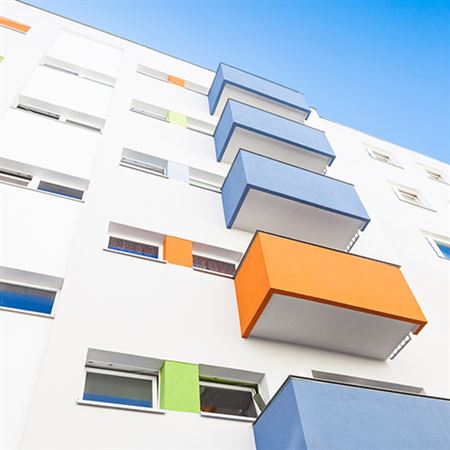
Colors can influence your mood, emotions, state of mind, and energy. For instance, when you see yellow or orange, you can’t help but feel happier and more energetic.
On the other hand, shades of blue and green won’t fail to make you feel calmer and more relaxed.
Since colors can affect a person’s mental and emotional state, they are often used in healthcare to help patients improve their psychological wellbeing which, in turn, can hasten their recovery.
Chromotherapy or colorology pertains to the use of color to help promote positive, therapeutic effects. This concept is applied in the architecture and interior design of medical and healthcare centers to create a relaxing and healing environment.
With colors having the ability to significantly change a person’s mood and provide them health benefits, choosing the right interior concrete paint hues to use in hospitals and healthcare facilities can work to the advantage of both patients and staff.
Colors and Wellness
Each color has a different effect on a patient’s mental health and overall recovery. Below is an overview of how the most popular hues can influence healing and wellness:
1. Yellow
This color is widely used in hospitals, clinics, and other healthcare facilities. Shades of yellow, especially lighter or pastel hues, are popular choices since they can evoke cheerfulness, lift spirits, and stimulate cognitive functioning and memory. They can also aid in pain relief and energize the muscles.
2. Orange
This color exudes warmth and is often associated with happiness. It has a mood-lifting, vibrant effect and gives vitality to the body, all of which can help hasten recovery.
3. Red
Red is a stimulating color, making it a great option for boosting a patient’s energy level and vitality. It also invigorates all the senses and enhances blood flow circulation and metabolism.
4. Pink
Pink is a lighter shade than red, making it a more soothing color that conveys care and affection. It is a compassionate and comforting hue that heals and soothes and stimulates happiness. In hospitals and healthcare facilities, it is often used to reduce or discourage erratic behavior.
5. Green
Shades of green are highly regarded for the sense of balance they impart and healing properties. Green is soothing and mildly energizing at the same time. It promotes relaxation, comfort, growth, and renewal, which are essential elements for faster recovery.
6. Blue
Like green, blue has a calming effect on the mind and body. It is known for its soothing properties that can help lower blood pressure and settle the nerves. It can aid in alleviating conditions involving inflammation, including headaches and migraines.
7. White
White is a universally healing color. It conveys feelings of comfort and unconditional love. Additionally, it can bring relief to just about any ailment, conflict, or situation.
Using the Right Colors in Medical Facilities
Below are some tips for choosing the right healing hues in specific areas in hospitals and healthcare facilities:
● Intensive care units
Neutral hues are the best choice for the paint color in intensive care units or ICUs. These convey calmness and peace yet create a warm ambiance that can help patients feel optimistic. White is also another good option since it implies sterility and gives both patients and visitors a sense of hygiene assurance.
● Operating rooms
Operating rooms or theater walls and ceilings are often painted with cooler, muted shades of green or blue-green to neutralize the afterimage that surgeons can get when they stare at something for too long, which can then affect their focus. These hues also help keep the doctors and other staff stay calm and think straight.
● Consultation rooms
Neutral palettes with soft hues are recommended for consultation rooms since these can calm anxious patients and their family members who are also stressed about having a loved one who is sick.
● Waiting rooms
Soothing and calming colors, such as blue and green, are also essential in areas where patients wait to be admitted and their loved ones will spend time waiting for news or updates about a family member or friend who is sick.
● Patient rooms
Neutral colors combined with soft greens and blues are recommended for patient rooms since these promote a relaxing, calming, and healing experience.
● Staff break rooms
Shades of dark blue and green help doctors, nurses, and other staff relax. As such, they are the recommended colors for break rooms.
When choosing which colors should go into specific rooms in hospitals and healthcare facilities, a good rule of thumb to remember is to always consider the persons who will use them frequently and for what reasons.
A children’s ward, for instance, can benefit from colorful and bright colors since these can help young patients feel at home, energetic, and optimistic during their stay.
On the other hand, geriatric wards require more contrast since most elderly patients have poor vision. The color disparities will help direct them to the rooms or areas where they want to go.
Geriatric wards, therefore, can benefit greatly from a more creative application of decorative paints in Dubai/.
In hospitals and healthcare facilities, paint colors are important for making rooms look attractive and spacious. They can also help calm down patients and facilitate faster recovery.
Because of these reasons, choose your paint colors wisely when renovating, improving, or building your medical or healthcare facility.
Our professional painters are ready to take on any painting projects for any type of facility.
Get in touch with us to find out how we can assist you.
